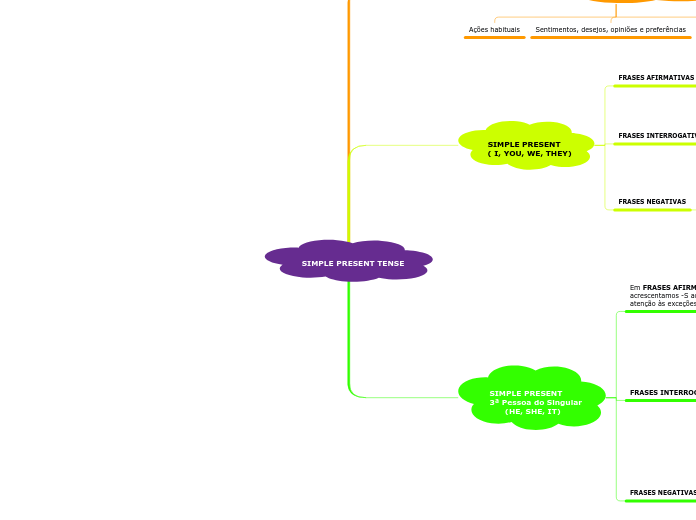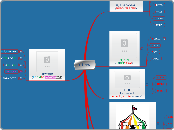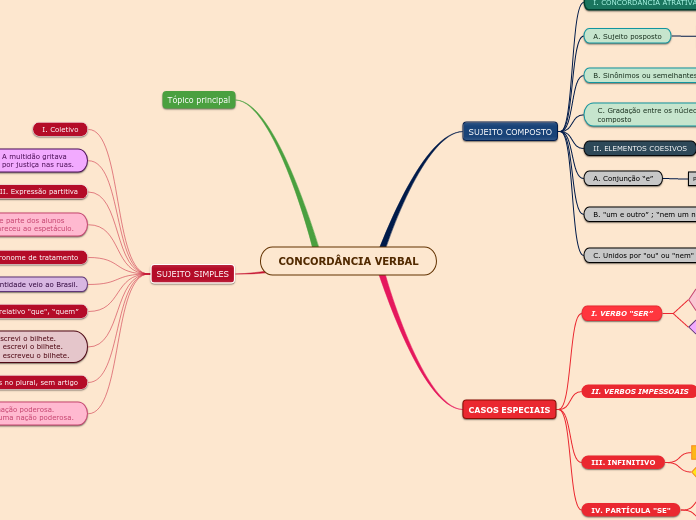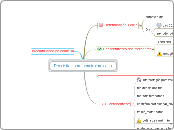SIMPLE PRESENT TENSE
Express your feeling and opinions about the people in your life, the books you have been reading, the weather and your favorite food.
SIMPLE PRESENT
3ª Pessoa do Singular
(HE, SHE, IT)
What is the worst book you read?
Type in the title.
Ao utilizar a forma negativa os verbos ficarão no infinitivo, sem o acréscimo do -S
A forma negativa é formada com o uso do verbo auxiliar DOES e da negativa NOT. Pode ser utilizado na forma completa (DOES NOT) ou na forma compacta (DOESN'T).
SUJEITO (PESSOA) + VERBO AUXILIAR + NOT + VERBO PRINCIPAL + COMPLEMENTO
What do you feel about this book?
How did it make you feel?
Try to come up with various descriptive adjectives that best describe the meaning of bad in this context.
boreddisappointinguninspiringunrealisticfrustrated
Ao utilizar a forma interrogativa os verbos ficam no infinitivo, sem o acréscimo do -S.
A forma interrogativa é formada pelo verbo auxiliar DOES, que é colocado no início das sentenças.
VERBO AUXILIAR (DOES) + SUJEITO + VERBO PRINCIPAL (SEM -S) + COMPLEMENTO
Em FRASES AFIRMATIVAS acrescentamos -S ao final dos verbos, atenção às exceções:
What food you dislike the most?
Verbos terminados em -Y precedido de consoante:
Retirar o -Y e acrescentar -IES
Verbos terminados em -Y precedido de vogal:
Acrescentar -S
Verbos terminados em: -SS, -SH, -CH, -X, -O, -Z Acrescentar -ES
Why do you dislike this food?
How does it make you feel?
Try to come up with various descriptive adjectives that best describe the meaning of bad in this context.
disgustingrottenblandgreasynasty
SIMPLE PRESENT
( I, YOU, WE, THEY)
FRASES NEGATIVAS
What is your favorite season?
A forma negativa é formada com o uso do verbo auxiliar DO e da negativa NOT. Pode ser utilizado na forma completa (DO NOT) ou na forma compacta (DON'T).
SUJEITO (PESSOA) + VERBO AUXILIAR + NOT + VERBO PRINCIPAL + COMPLEMENTO
Why do you like this season?
How does it make you feel?
Try to come up with various descriptive adjectives that best describe the meaning of good and nice in this context.
pleasantsunnyrelaxedinvigoratingmild
FRASES INTERROGATIVAS
What is your favorite book?
Type in the title.
A forma interrogativa do Simple Present é formada com o uso do verbo auxiliar DO no início das sentenças.
VERBO AUXILIAR (DO) + SUJEITO (PESSOA) + VERBO PRINCIPAL + COMPLEMENTO
What is your impression of this book?
How did it make you feel?
Try to come up with various descriptive adjectives that best describe the meaning of good and nice in this context.
entertainedexcitingpositiveexcellentengaging
FRASES AFIRMATIVAS
What is your favorite food?
Para conjugar um verbo no Simple Present, basta usá-lo no infinitivo, ou seja, sem o TO.
SUJEITO (PESSOA) + VERBO PRINCIPAL NO INFINITIVO (SEM TO) + COMPLEMENTO
Why is it your favorite food?
How does it make you feel?
Try to come up with various descriptive adjectives that best describe the meaning of good and nice in this context.
delicioushealthynutritioussatisfiedsavory
Suggestions:
- delicious
- healthy
- nutritious
- satisfied
- savory
QUANDO USAR O SIMPLE PRESENT
Verdades Universais
Sentimentos, desejos, opiniões e preferências
Ações habituais
Who is the best person in the world for you? Type in the answer.
motherfathergrandfathersisterbrothergrandmotherbest friend









